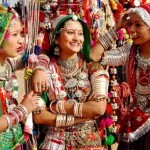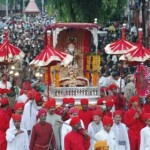Teej is one of the most widely celebrated festivals in Northern India, especially Rajasthan. In the desert state, it is a grand affair and is celebrated with great enthusiasm during the Shraavana month. It marks the advent of monsoon. Swings are hung from trees and women dressed in green clothes sing songs in celebration of the advent of the monsoon.
 According to mythology, Goddess Parvati was reunited with her consort Lord Shiva on this day after intense tapasya or penance of 108 births on earth. It was then that the Goddess is said to have proclaimed the moment to be extremely auspicious for womenfolk and declared that if women invoked her on this day, they would be blessed with a happy married life and their wishes would be fulfilled.
According to mythology, Goddess Parvati was reunited with her consort Lord Shiva on this day after intense tapasya or penance of 108 births on earth. It was then that the Goddess is said to have proclaimed the moment to be extremely auspicious for womenfolk and declared that if women invoked her on this day, they would be blessed with a happy married life and their wishes would be fulfilled.
The women dress in fine clothes and gather at the nearby temple and offer prayers to Goddess Parvati for the well being of their husband. During the festival, women observe the nirjala vrat and spend three sleepless nights, symbolic of Parvati’s penance.
 Teej is one of those times in the year when the markets are laden with the trendiest of accessories and clothes for women while sweet shops do a roaring trade in Mal Puas and Ghewar, the traditional sweet of Teej and monsoon.
Teej is one of those times in the year when the markets are laden with the trendiest of accessories and clothes for women while sweet shops do a roaring trade in Mal Puas and Ghewar, the traditional sweet of Teej and monsoon.
 In Rajasthan’s capital, Jaipur, an elaborate procession is taken out for two consecutive days on this occasion, attracting thousands of Indian and foreign tourists. The Teej idol is covered with a canopy whereas the Gangaur idol is kept open. The high point is the magnificent idol of Parvarti in a palanquin. Antique palanquins made of gold, bullock carts pulling cannons, chariots, elaborately adorned elephants, camels, band and folk dancers add glitz and glamour to the event. Some of the devotees dress like the Gods and Goddesses and play various instruments and prasad is distributed amongst all devotees.
In Rajasthan’s capital, Jaipur, an elaborate procession is taken out for two consecutive days on this occasion, attracting thousands of Indian and foreign tourists. The Teej idol is covered with a canopy whereas the Gangaur idol is kept open. The high point is the magnificent idol of Parvarti in a palanquin. Antique palanquins made of gold, bullock carts pulling cannons, chariots, elaborately adorned elephants, camels, band and folk dancers add glitz and glamour to the event. Some of the devotees dress like the Gods and Goddesses and play various instruments and prasad is distributed amongst all devotees.
